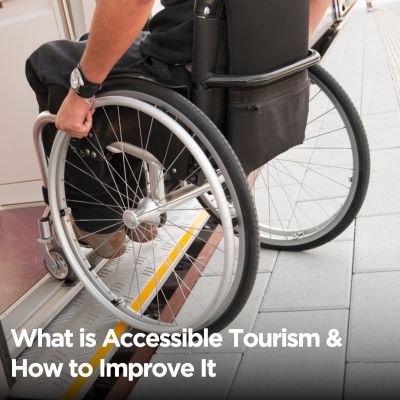Travel should be an experience that everyone can enjoy, yet for millions of people with disabilities, seniors, and those with mobility challenges, it often comes with unnecessary barriers.
Accessible tourism is a movement that ensures travel is inclusive, providing equal access to transportation, accommodations, and attractions.
It’s not just about wheelchair ramps; but it’s about creating seamless experiences for all travelers, including those with sensory, cognitive, or temporary mobility impairments.
The demand for accessible travel is growing rapidly, with the market expected to reach $1.2 trillion globally as more destinations recognize the need for inclusivity.
Businesses that prioritize accessibility enhance the travel experience and also tap into a vast, often overlooked customer base.
Governments, tourism operators, and travelers must work together to remove barriers, implement inclusive policies, and design travel experiences that cater to everyone, ensuring that no one is left behind.
What is Accessible Tourism?
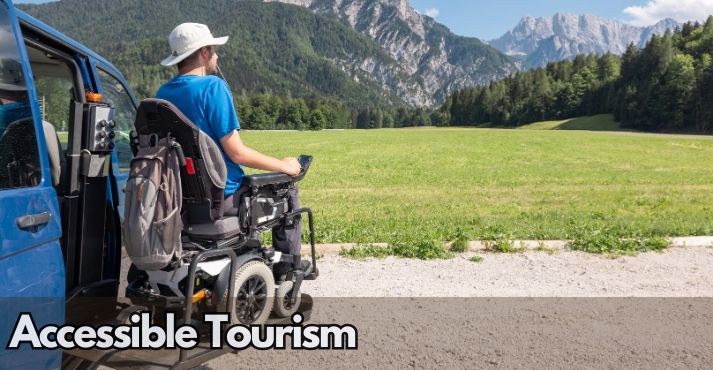
Accessible tourism is an approach that ensures travel, accommodations, and attractions are inclusive for all travelers, including those with physical, sensory, and cognitive disabilities.
It focuses on removing barriers that may prevent people from enjoying travel experiences, whether due to mobility challenges, visual or hearing impairments, or neurodiverse conditions.
The goal is to create a tourism industry where everyone, regardless of ability, can explore destinations with ease and dignity.
While many associate accessibility with wheelchair ramps, true accessible tourism includes step-free public transport, braille signage, and digital booking platforms compatible with screen readers.
Cities like Barcelona offer accessible beaches with amphibious chairs, Singapore has disability-friendly public transport, and Sydney Opera House provides captioning and audio descriptions for performances.
These initiatives enhance travel experiences and expand tourism opportunities for millions worldwide.
Why Is Accessible Tourism Important?
Accessible tourism is not just about inclusivity. It is also a major economic driver. With 15% of the global population living with a disability, the demand for accessible travel continues to grow.
Millions of travelers seek destinations that accommodate their needs, making accessibility a crucial factor in tourism development.
Businesses that invest in accessibility attract a wider customer base, from travelers with disabilities to families with strollers and elderly tourists.
According to the World Tourism Organization (UNWTO), accessible tourism can significantly boost revenue for hotels, airlines, and tourist attractions by opening doors to a larger, often underserved audience.
As the demand for inclusive travel rises, businesses that prioritize accessibility gain a competitive edge.
In addition to financial benefits, barrier-free travel enhances social inclusion by allowing people with disabilities to explore, experience, and participate in leisure activities without restrictions.
Tourism should be a right, not a privilege. That is why governments, businesses, and industry leaders have legal and ethical responsibilities to ensure accessibility.
Many countries have enacted regulations requiring accessible infrastructure, and businesses that comply meet legal standards while creating a more inclusive and welcoming travel experience.
Who is Involved in Accessible Tourism?
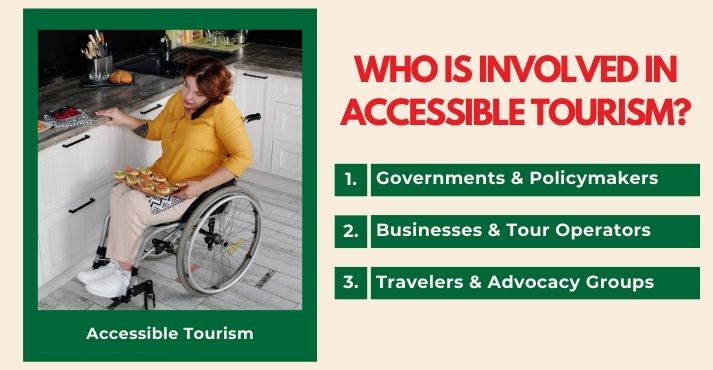
Ensuring barrier-free tourism requires collaboration from multiple stakeholders. Governments, businesses, and advocacy groups contribute to making accessible travel destinations a reality.
By working together, they help create an inclusive travel environment that benefits both travelers and the tourism industry.
1. Governments and Policymakers
Governments establish accessibility standards and enforce regulations that influence the travel industry. They implement policies requiring hotels, public transportation, and attractions to accommodate travelers with disabilities.
For example, the Americans with Disabilities Act (ADA) in the United States mandates wheelchair accessibility in public spaces, while the European Accessibility Act sets guidelines for transport, accommodations, and digital services.
In some countries, grants and incentives encourage businesses to invest in accessible infrastructure, ensuring that travel is more inclusive for all.
Singapore has made significant strides in accessible tourism, especially on Sentosa Island. The island features an accessible beach track at Siloso Beach, slip-resistant walkways, and inclusive attractions.
Additionally, the Sentosa Wheel Venture Accessibility Tour provides a fully accessible experience for travelers with disabilities, setting a high standard for travel accessibility solutions in the region.
2. Businesses and Tourism Operators
Hotels, airlines, tour operators, and attractions have a responsibility to enhance accessibility. Many accommodations now offer step-free entry, accessible hotel rooms, and adaptive technology for guests with hearing or vision impairments.
Airlines provide mobility assistance, and some tour companies design itineraries suited for travelers with disabilities.
Accessible travel destinations like Sydney and Barcelona have set high standards, with wheelchair-friendly public transport, accessible beaches, and inclusive attractions that welcome all visitors.
3. Travelers and Advocacy Groups
Travelers with disabilities and advocacy groups call for better accessibility by voicing their needs and influencing industry standards.
Reviews and accessibility ratings on platforms like TripAdvisor and Google Maps help highlight both challenges and success stories, encouraging businesses to improve their services.
On average, a business needs about 40 reviews before achieving an average star rating, showing the significant impact of customer feedback on how accessibility efforts are perceived.
Organizations such as Disabled Accessible Travel and The European Network for Accessible Tourism (ENAT) advocate for policy changes and support initiatives that make tourism more inclusive.
Their efforts ensure that travel accessibility solutions become more widespread, making inclusive travel experiences more readily available to all.
By sharing feedback and supporting accessibility-focused businesses, travelers and advocacy groups help ensure meaningful improvements in the tourism industry.
How Can Tourism Be Made More Accessible?
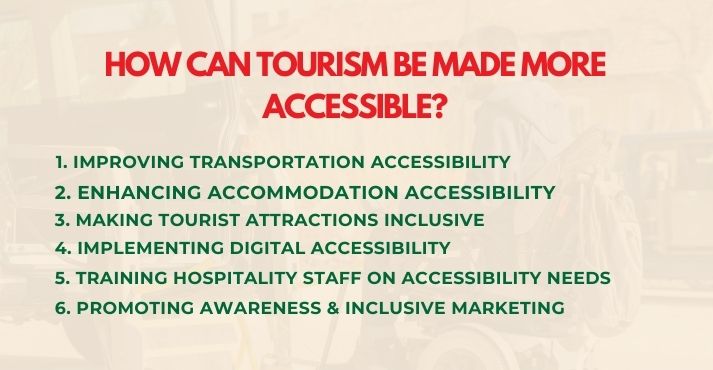
Making tourism more accessible benefits not only travelers with disabilities but also seniors, families with young children, and anyone who faces mobility challenges.
By improving transportation, accommodations, attractions, and digital services, the tourism industry can ensure disability-friendly travel for everyone.
The following strategies show how accessibility improvements can make a significant impact on the tourism industry, ensuring that travel is inclusive for everyone.
1. Improving Transportation Accessibility
Accessible transportation is essential for tourism for people with disabilities, allowing them to navigate airports, buses, trains, and taxis with ease.
Airports are incorporating features like wheelchair-friendly terminals, tactile paving, and audible announcements to enhance accessibility.
Many cities worldwide are making public transportation more inclusive. Singapore’s MRT system is a leading example, with barrier-free access at all train stations, tactile guidance paths, and lifts with Braille buttons.
Additionally, Japan’s Shinkansen bullet trains provide reserved wheelchair spaces, accessible restrooms, and step-free boarding options, ensuring a smooth travel experience for passengers with mobility challenges.
To further improve accessibility, ride-hailing services like Uber and Lyft have introduced wheelchair-accessible vehicles (WAVs) in select cities, offering a more flexible transport option for travelers.
These innovations help ensure that getting around is not a barrier to exploring new destinations.
2. Enhancing Accommodation Accessibility
Hotels have an important role in making travel accessible for everyone. Accessible accommodations include step-free entrances, wider doorways, lowered counters, and bathrooms with grab bars and roll-in showers.
Many international hotel chains are prioritizing accessibility. Marriott’s “Room for All” initiative focuses on universal design, ensuring their properties have features such as lowered peepholes, visual fire alarms, and accessible furniture arrangements.
Similarly, Hilton offers hearing-accessible rooms equipped with TTY devices, vibrating alarm clocks, and door-knock alert systems to assist guests with hearing impairments.
Some boutique hotels and independent accommodations are also leading the way to improve guest experience. For example, Hotel Brooklyn is known for its accessible design, featuring floating beds, hoist-compatible furniture, and high-contrast colors for visually impaired guests.
3. Making Tourist Attractions Inclusive
Museums, parks, and historical sites are becoming more disability-friendly by incorporating ramps, audio descriptions, and tactile exhibits.
Many cultural institutions are improving their spaces to provide step-free access, sensory-friendly environments, and accommodations for visitors with diverse needs.
Guided tours with sign language interpreters, braille information panels, and interactive exhibits designed for individuals with visual or hearing impairments are becoming more common.
Outdoor attractions are also prioritizing accessibility by creating wheelchair-friendly trails, adaptive recreation opportunities, and inclusive visitor services.
National parks and heritage sites are introducing all-terrain wheelchairs, accessible viewpoints, and virtual tours to ensure that everyone can experience natural and cultural landmarks.
These efforts enhance tourism for people with disabilities and promote equality and inclusion in hospitality, ensuring that travel experiences are welcoming for all.
4. Implementing Digital Accessibility in Tourism Services
Accessible digital platforms allow travelers with disabilities to research, book, and plan their trips with ease.
Websites, booking platforms, and travel apps should follow Web Content Accessibility Guidelines (WCAG), ensuring text-to-speech compatibility, keyboard navigation, and alternative text for images.
Airbnb and Booking.com have introduced accessibility filters, enabling travelers to search for accommodations with step-free access, roll-in showers, and other mobility-friendly features.
Providing accessibility information upfront not only helps travelers make informed decisions but also encourages businesses to continuously improve their services.
5. Training Hospitality Staff on Accessibility Needs
Educating staff about accessibility needs can significantly improve customer journeys and experiences. Hotels, airlines, and tourist attractions should provide training programs that teach employees how to assist guests with disabilities.
Disney Parks & Resorts sets an industry benchmark with its Disability Access Service (DAS) training, ensuring that staff members are equipped to assist guests with mobility, visual, and cognitive impairments.
Similarly, airlines like Qantas and Emirates conduct accessibility awareness programs for their flight attendants, teaching them how to interact with and assist passengers with special needs.
Certifications such as Disability Awareness Training (DAT) and WorldHost Inclusive Service help hospitality professionals develop the skills needed to accommodate travelers with diverse accessibility requirements.
6. Promoting Awareness and Inclusive Marketing
Travel businesses can attract a larger audience by promoting accessible travel services in their marketing campaigns.
While one in four people live with a disability, only 1% of ads represent them. Therefore, featuring real stories of travelers with disabilities in advertisements promotes inclusivity and representation.
Showcasing accessible accommodations, transportation options, and tourist attractions in promotional content helps potential travelers feel confident in their ability to explore new destinations.
Additionally, attending hospitality trade shows provides an opportunity for businesses to network, promote accessibility-focused services, and stay informed about travel accessibility solutions.
Along with marketing, businesses should ensure their websites and booking platforms follow accessibility standards, such as providing screen reader compatibility, alternative text for images, and clear navigation options.
By implementing these strategies, the tourism industry can create a more inclusive and accessible travel experience.
Challenges in Implementing Accessible Tourism
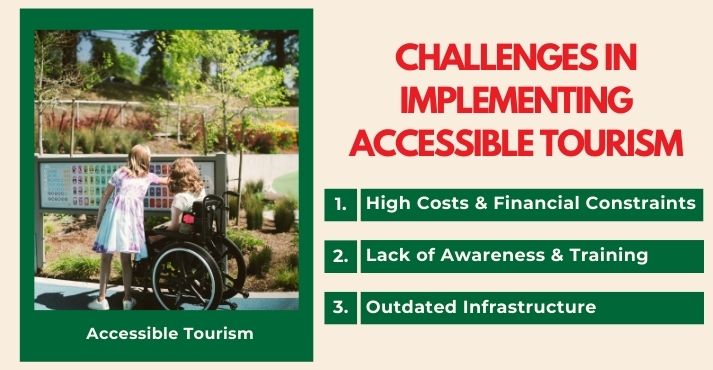
While progress has been made in making travel more inclusive, significant challenges remain. Many destinations and businesses struggle to meet accessibility standards due to financial constraints, outdated infrastructure, and a lack of awareness.
Overcoming these barriers requires a commitment from governments, businesses, and communities to invest in accessibility improvements and create a more inclusive travel experience.
High Costs and Financial Constraints
One of the biggest challenges in implementing accessible tourism is the cost of upgrading infrastructure. Installing ramps, elevators, tactile paving, and accessible restrooms can be expensive, especially for small businesses or heritage sites with architectural limitations.
Retrofitting older buildings to accommodate disability-friendly travel often requires structural modifications that some businesses find financially burdensome.
Solution:
Governments can provide incentives, grants, or tax breaks to encourage businesses to invest in accessibility.
For example, Singapore’s Accessibility Fund helps businesses offset the cost of upgrading their premises to meet accessibility standards, making tourism for people with disabilities more feasible.
Lack of Awareness and Training
Many tourism businesses fail to recognize the importance of accessibility simply because they are unaware of the challenges faced by travelers with disabilities.
Hotel staff, airline personnel, and tour operators may lack the training needed to assist guests with specific needs. This can lead to unintentional discrimination or poor service for travelers requiring accommodations.
Solution:
Comprehensive training programs can equip hospitality staff with the knowledge to assist travelers with disabilities effectively.
In Japan, major train stations have staff trained in assisting visually impaired travelers by guiding them through stations and helping with ticket purchases, setting a strong example of inclusive service.
Outdated Infrastructure and Resistance to Change
Many older buildings, streets, and public transportation systems were not originally designed with accessibility in mind. Renovating these spaces can be challenging, especially in historic sites where preserving aesthetics is a priority.
Some businesses may resist accessibility improvements, fearing that changes will compromise the visual appeal of their establishments.
Solution:
Smart design solutions can ensure accessibility without compromising aesthetics. For instance, Barcelona has successfully integrated accessible features into its historic sites by using discreet ramps and lifts that blend into the architecture while ensuring full access for all visitors.
By addressing these challenges through financial support, education, and innovative design, the tourism industry can move closer to ensuring that all travelers, regardless of their abilities, can explore the world without barriers.
The Future of Accessible Tourism
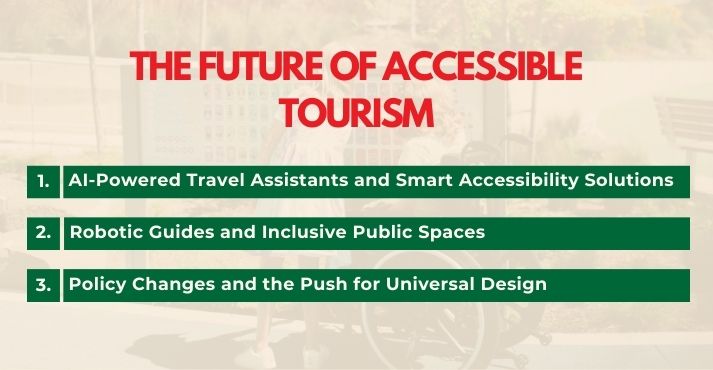
The future of accessible tourism will improve through advancements in technology, innovative solutions, and policies that make travel easier for everyone.
As more businesses realize the importance of inclusive tourism, new tools and services will continue to emerge. From artificial intelligence (AI) travel assistants to smart infrastructure, these advancements will help people with disabilities travel more conveniently and comfortably.
AI-Powered Travel Assistants and Smart Accessibility Solutions
Artificial intelligence is making travel more accessible by providing real-time assistance to people with disabilities. AI-powered virtual assistants and chatbots can give instant travel updates and personalized recommendations based on individual accessibility needs.
For visually impaired travelers, apps like Be My Eyes connect them with sighted volunteers who assist remotely, while Google’s Lookout App uses AI to identify objects, read text, and help users navigate unfamiliar places.
In the hospitality sector, many hotels now feature voice-activated controls and smart automation, allowing guests to adjust lighting, temperature, and entertainment without physical assistance.
Self-service kiosks are also improving accessibility in airports, hotels, and tourist attractions. Many modern kiosks now include features like voice commands, braille keypads, and adjustable screens to accommodate travelers with disabilities.
AI is becoming a standard tool in tourism, with nearly every company in the industry using at least one AI-powered technology.
The market is expected to grow significantly, reaching an estimated $1.2 billion by 2026, as more businesses integrate AI to improve accessibility and enhance the travel experience for everyone.
Robotic Guides and Inclusive Public Spaces
Robotic technology is helping make public spaces more accessible. Airports and museums are using robotic guides that provide personalized navigation and real-time information to people with mobility impairments.
For example, Tokyo’s Haneda Airport has introduced self-driving robotic wheelchairs that allow passengers to move through the terminal independently without needing assistance from airport staff.
Developed by WHILL, these autonomous personal electric vehicles (EVs) come equipped with sensors to detect obstacles and an automatic stop function, enhancing accessibility and reducing wait times for travelers with limited mobility.
Many cities are also working on making public spaces more inclusive. Smart cities are using sensor-based navigation systems and adaptive traffic signals to help visually impaired pedestrians move safely through urban areas.
One leading example is Singapore’s Smart Nation Initiative, which integrates accessibility into city planning, ensuring that public spaces, transportation, and services are designed for people of all abilities.
Hotels and airports are also implementing contactless hospitality solutions to enhance accessibility. From voice-activated room controls to self-check-ins and digital concierge services, these innovations provide a seamless experience for travelers with disabilities.
Policy Changes and the Push for Universal Design
Governments around the world are strengthening accessibility regulations to ensure that travel services accommodate all individuals.
For example, the European Union’s Accessibility Act is introducing new rules that will improve accessibility in transportation, hotels, and digital services across Europe.
Meanwhile, organizations like the World Tourism Organization (UNWTO) advocate for universal design, meaning accessibility should be a standard part of all travel services, not an extra feature.
As the travel industry advances, accessibility improvements are essential for inclusivity. With new technology, stronger policies, and universal design, tourism will become more welcoming, allowing everyone to explore the world without barriers.
Conclusion
Accessible tourism is essential for making travel inclusive for everyone. Removing barriers and ensuring disability-friendly experiences allow destinations to welcome more visitors while enhancing overall travel quality.
Prioritizing accessibility makes tourism more enjoyable, convenient, and fair. Governments, businesses, and travelers each influence the accessibility of tourism. Policymakers must enforce equal access to transportation, accommodations, and attractions.
Businesses should invest in accessibility, from physical upgrades to digital improvements. Travelers, especially those with disabilities, can create change by sharing feedback, supporting accessible services, and advocating for better solutions.
By implementing best practices, investing in innovation, and promoting inclusivity, the travel industry can create a world where everyone, regardless of ability, can explore without limitations.

